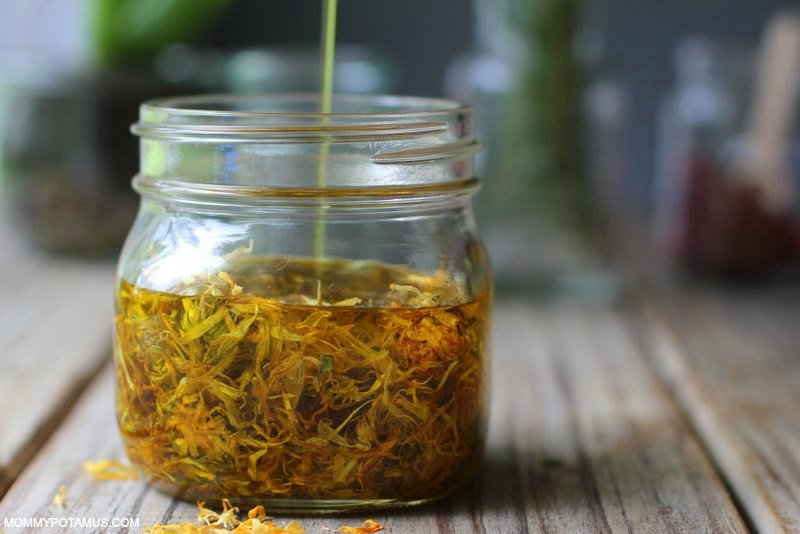
I eat pansies for breakfast.
Like, the actual flowers. Not very often, but enough to want a t-shirt that says so.
Edible flowers are more than just a fun conversation starter, though. The soothing properties of calendula (Calendula officinalis), for example, have a long history of use in both folk medicine and culinary traditions.
Gentle enough for babies and yet potent enough to draw the attention of researchers, calendula is often used as first aid for cuts, scrapes and bug bites, to soothe a sunburn, as a rinse for pinkeye, relief for sore throats, and as a salve for diaper rash.
PubMed is full of fascinating studies that are exploring its many benefits . . . some of which we’ll dive into later in this article.
On the culinary side, calendula petals have traditionally been added to butter, cheese and custards to enhance their golden color. Because its flavor is similar to saffron – which tends to be pretty pricey – it’s sometimes used as a substitute. Unlike rare herbs that tend to be expensive and difficult to find, calendula is easy to grow or buy for an affordable price.
As always, none of these statements have been evaluated by the FDA and is not meant to diagnose, cure, or treat any condition. Okay, let’s dive in!
What is calendula oil?
Calendula flowers contain a wide variety of beneficial compounds – particularly triterpenoids and flavonoids – that have both external and internal therapeutic effects. They’re often brewed into a tea, prepared as a tincture, or extracted into oil. Let’s take a look at these preparations and how they’re used:
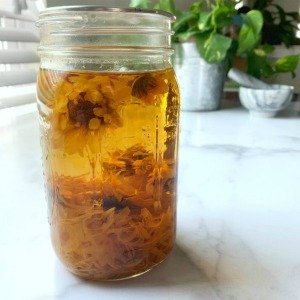
Tea Extractions – Water based extracts (aka tea) are usually consumed internally, but occasionally some (like calendula and chamomile) are used externally for issues like skin or eye irritation.
In general they have a very short shelf life, however some very concentrated teas are mixed with honey to make long-lasting herbal syrups such as elderberry syrup.
Tinctures – This type of herbal preparation uses alcohol or glycerin to extract beneficial compounds, which gives them an extremely long shelf life. They’re taken internally and used occasionally for external wound care or other skin applications. Some examples of tinctures are this one for restful sleep and this one for adrenal support.
Oil Extractions – The calendula oil recipe below and this plantain oil recipe are both oil extractions, which have a much longer shelf life than tea. They’re most often used externally, however calendula oil also makes a delicious, gut-soothing addition to homemade salad dressing. (Use it like you would regular olive oil.)
Also known as infused oils, herbs extracted using oil can be made in a number of ways. In the tutorial below I’ll share two methods with you. With both methods the goal is the same – mix herbs and oil so that the oil can draw out the helpful properties of the herbs.
Don’t have time to make your own?
One of the most common questions I get when I post a recipe is “Hey, do you sell this?”
I get it, no one has time to make #allthethings all the time! Although I don’t have a shop to sell the recipes I share here, I can recommend this organic calendula oil if you’re looking for a pre-made option.
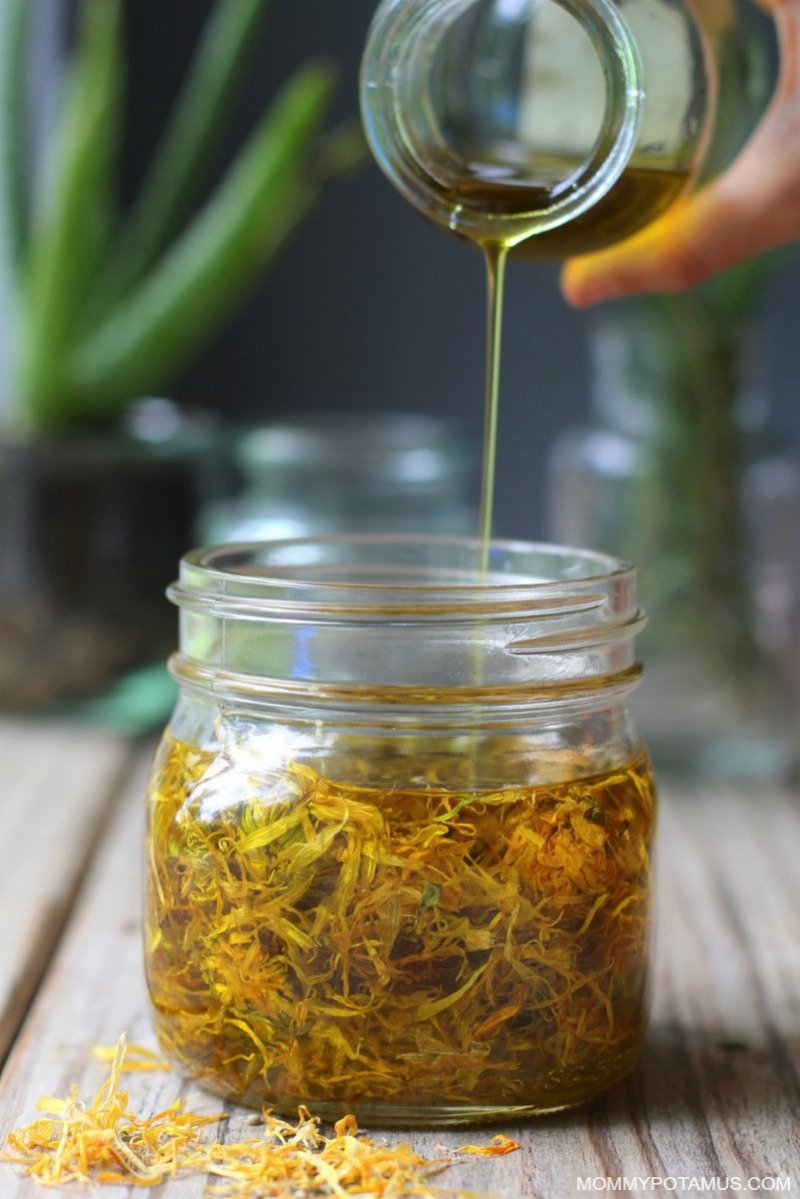
How do I use calendula oil?
Calendula’s soothing properties make it a favorite for supporting wound healing, nourishing skin and promoting gut health. It’s often used as:
- First aid for cuts, scrapes, burns, sunburns, bug bites and other minor skin irritations. I make the oil into a calendula salve that can be kept in my purse without leaking.
- Face and lip care – Infused calendula oil is the “secret ingredient” behind many beloved face serums and lip balms. Use it in place of regular olive oil in this lip balm recipe.
- Diaper rash – I like to apply the oil (or a salve made from it) and then sprinkle some bentonite clay over the area. Both calendula oil and clay are considered cloth diaper friendly.
- Chapped or dry skin – Calendula is thought to support the integrity of skin, thus allowing it to retain healthy moisture levels.
- Salad dressing – Yep, really! Calendula is considered soothing for the skin and the digestive tract. It has a mild flavor similar to saffron. I use it in a basic salad dressing recipe in place of plain olive oil.
- Massage oil – You can read more about the benefits of massage here, and calendula oil can be used as the carrier oil in the recipes listed.
- Body butter – Here’s a recipe to try.
How To Make Calendula Oil
Calendula’s soothing properties make it a favorite for supporting wound healing, nourishing skin and even promoting gut health. Here are two super easy methods for making it into an infused oil.
Ingredients
- Organic dried whole calendula flowers
- Olive oil (Or another oil that you prefer. Avocado and almond oil are good options, as is jojoba. However, jojoba is not edible so don’t use if if you’re planning to use your calendula in salad dressing.)
#1 Instructions (Slow Method)
This is the traditionally preferred method because it’s thought to best preserve the delicate constituents found in calendula. However, sometimes it’s just not practical to wait 4-6 weeks for a batch. For those times, I’ve included a faster method below.
- Place calendula petals in a clean, dry glass jar. Next, pour in the olive oil – add enough so that the petals are covered by about one inch of oil. My petals usually float when I first add the oil and then settle, so I watch the bottom of the jar to make sure there’s about 1 inch of pure oil so that I’m sure I’ve added enough. The reason this is done is that the petals expand as they soak in the liquid, so you add extra to ensure that they stay covered.
- Cover the jar with a tight fitting lid and give it a good shake. Place the jar in a paper bag and store near a warm, sunny window. Some people skip the paper bag, but others believe it helps protect some of the valuable constituents found in calendula from breaking down due to UV light – I prefer the bag method. Give the jar a good shake when you walk by it every day.
- Once the oil has been infusing for 4-6 weeks, strain out the calendula petals and pour the oil in a clean, glass jar. Store in a cool, dark cabinet until needed.
#2 Instructions (Quick Method)
- Place calendula petals in a clean, dry glass jar. Next, pour in the olive oil – add enough so that the petals are covered by about one inch of oil. My petals usually float when I first add the oil and then settle, so I watch the bottom of the jar to make sure there’s about 1 inch of pure oil so that I’m sure I’ve added enough. The reason this is done is that the petals expand as they soak in the liquid, so you add extra to ensure that they stay covered.
- Cover the jar with a tight fitting lid and give it a good shake.
- Place a kitchen towel in the bottom of your slow cooker and place your jar inside. Add enough water to cover about half the jar and set to the lowest setting for 2-6 hours. I set mine to warm. Whether or not you place the lid on the slow cooker is largely determined by how hot it gets and how long you plan to infuse it. If you’re infusing it on low for 2-3 hours the lid will probably be helpful in helping it warm up more quickly and retain heat better, but if you’re infusing for 3-6 hours the lid may cause too much heat to be retained. You can always start with the lid and remove it if you decide to extend the infusing time. If your slow cooker tends to run hot I recommend leaving the lid off.
- Strain out the calendula petals using cheesecloth and pour the oil in a clean, glass jar. Store in a cool, dark cabinet until needed.
Safety Considerations
According to the Botanical Safety Handbook, calendula is a Safety Class 1A herb – the safest rating possible. However, older studies report that the internal use of calendula may stimulate menstruation, so it is not recommended for internal use during pregnancy. Topical use is considered fine.
Also, individuals who are allergic to ragweed may find that they are also sensitive to calendula.
As always, please check with your healthcare provider before using any herbal remedy.
Important Note: Infused oils are very different from essential oils, which I do not recommend taking internally unless under the care of a qualified healthcare provider. Infused oils use a carrier oil to extract components of the whole plant, while essential oils only extract the light aromatic compounds found in the plant.
Frequently Asked Questions
Is calendula the same plant as marigold?
Sometimes called pot marigold, calendula (Calendula officinalis) is different from the common marigold (Tagetes spp.) you’ll find in most garden centers. They’re part of the same family, though – Asteracea – along with daisies and chrysanthemums.
Why use whole flowers instead of just the petals?
I prefer them because dried whole flower with the green base tend to be more potent.
Can I use fresh calendula flowers?
If you use freshly-harvested flowers you’ll want to dry them before you infuse them in order to prevent mold or spoilage. I outline the method for using fresh flowers in my dandelion oil recipe.
What is the shelf life of this herbal oil?
The shelf life of herbal oils is primarily determined by the shelf life of the carrier oil and the conditions it is stored in. Olive oil tends to have a shelf life of 1-2 years provided it is stored in a cool, dry place out of direct sunlight.
An antioxidant such as vitamin E can be added to protect oils from early oxidation. I use 1/2 teaspoon of vitamin E tocotrienols per 1 cup of oil.
More Nourishing Skin Care Recipes
Arnica Oil & Cream – Arnica has been traditionally used by Swiss mountaineers to prevent muscle soreness, and according to The New York Times, “scientists have found good evidence that it works.” When I injured my shoulder awhile ago, I made up a batch of arnica cream to use along with physical therapy. It was so helpful and it’s very simple to make, too!
Plantain Salve – Can you really make a first aid ointment out of a backyard weed and items in your pantry? Yes you can, and chances are your kids will love helping you gather “medicine.”
How To Make Calendula Oil
Instructions
Traditional Method
- Place calendula petals in a clean, dry glass jar. Next, pour in the olive oil – add enough so that the petals are covered by about one inch of oil. My petals usually float when I first add the oil and then settle, so I watch the bottom of the jar to make sure there's about 1 inch of pure oil so that I'm sure I've added enough. The reason this is done is that the petals expand as they soak in the liquid, so you add extra to ensure that they stay covered.
- Cover the jar with a tight fitting lid and give it a good shake. Place the jar in a paper bag and store near a warm, sunny window. Some people skip the paper bag, but others believe it helps protect some of the valuable constituents found in calendula from breaking down due to UV light – I prefer the bag method. Give the jar a good shake when you walk by it every day.
- Once the oil has been infusing for 4-6 weeks, strain out the calendula petals and pour the oil in a clean, glass jar. Store in a cool, dark cabinet until needed.
Faster Method
- Place calendula petals in a clean, dry glass jar. Next, pour in the olive oil – add enough so that the petals are covered by about one inch of oil. My petals usually float when I first add the oil and then settle, so I watch the bottom of the jar to make sure there's about 1 inch of pure oil so that I'm sure I've added enough. The reason this is done is that the petals expand as they soak in the liquid, so you add extra to ensure that they stay covered.
- Cover the jar with a tight fitting lid and give it a good shake.
- Place a kitchen towel in the bottom of your slow cooker and place your jar inside. Add enough water to cover about half the jar and set to the lowest setting for 2-6 hours. I set mine to warm. Whether or not you place the lid on the slow cooker is largely determined by how hot it gets and how long you plan to infuse it. If you're infusing it on low for 2-3 hours the lid will probably be helpful in helping it warm up more quickly and retain heat better, but if you're infusing for 3-6 hours the lid may cause too much heat to be retained. You can always start with the lid and remove it if you decide to extend the infusing time. If your slow cooker tends to run hot I recommend leaving the lid off.
- Strain out the calendula petals using cheesecloth and pour the oil in a clean, glass jar. Store in a cool, dark cabinet until needed.
Want research-backed natural remedies?
No problem, I’ve created a free ebook for you – Kitchen Apothecary: 25+ Natural Remedies Using Ingredients From Your Pantry – as a gift for signing up for my newsletter. You’ll also get updates when I post about safe essential oils for pregnant/breastfeeding mamas, exclusive gifts and coupons (I was able to give away a jar of free coconut oil to anyone who wanted it recently!), plus other goodies.
Sign up using the form below.
Sources
Della, Loggia R., et. al. (1994) The role of triterpenoids in the topical anti-inflammatory activity of Calendula officinalis flowers

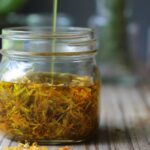
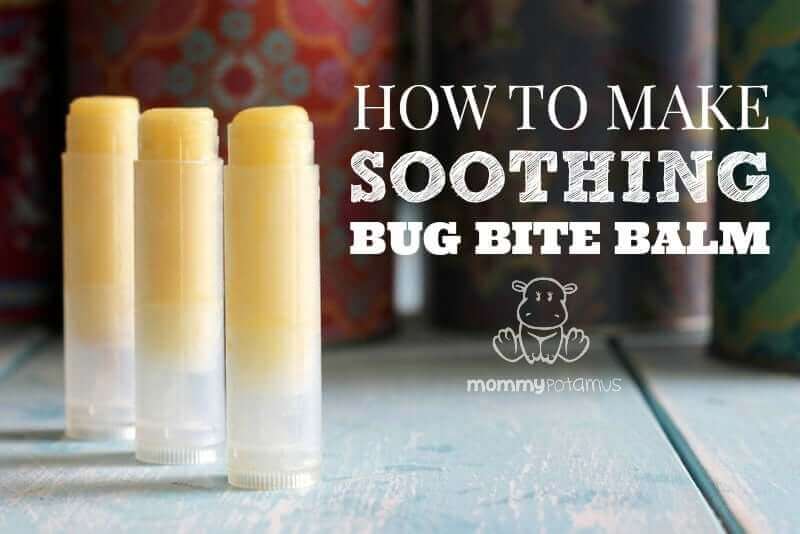
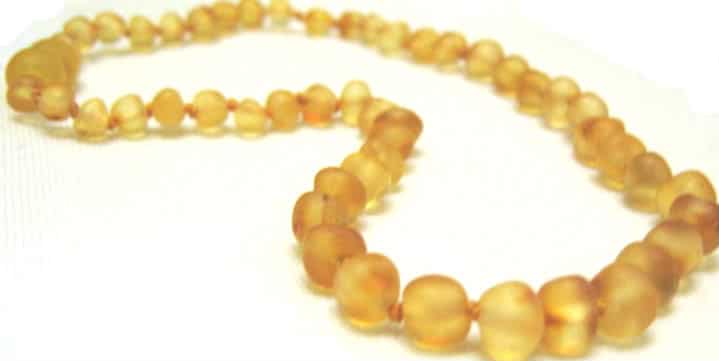
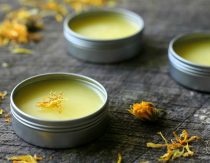

What great timing! I am growing Calendula for the first time this year. Looking forward to the post on making a salve.
Can you take pictures of each page of your free gift: The Kitchen Apothecary E-Book and email them to me (my phone will not open a pdf)?
I would like to grow it but I have wild rabbits around. They ate it down to the ground the last time I tried to grow it.
I have tons of rabbits, and the left my calendula alone. I do have them surrounded by nasturtiums, other marigolds, and mums. Not sure if that helps.
Hello! Question about the quick method. When you place the jar in the crock pot and cook on medium, is the lid on the crock pot? The way I’m picturing it, the jar would be too high for the lid to go on? Thank you!
Do the calendula petals have to be dried first? Or can they be fresh?
They must be dried or they can mold. Dry them thoroughly in a cool Dark place. I pick mine when they are nearly dry, sort of wrinkly, then spread them on a paper plate. They dry quickly if it’s not humid and retain their color. You can dry them in a paper bag too!
Is Calendula good for insect bite itches? If not, what would you recommend? My daughter is covered in mosquito and black fly bites and she finds them incredibly itchy. We’ve been using tea tree oil, which helps to a degree, but not enough (at least it keeps the infection at bay).
Calendula is one of the preferred herbs for soothing bug bites in folk medicine. 🙂
I put some oatmeal in a blender and ground it up to more of a flour state and then put a cup full in a warm bath and had a soak for 20 minutes (watched a rerun of a comedy on netflix to pass the time) and then patted dry (not rubbed). It took away the itch as long as I didn’t scratch the bites. I had more than 20 mosquito bites and it really worked. It took the edge off except for a few on the bigger ones that I accidentally scratched (which started up the itching again). I had a gelatinous like mess when the tub drained but I didn’t mind because it took care of the itch in places I couldn’t reach.
I made calendula salve last year using home grown and dried calendula petals that I infused in almond oil and kept on a sunny windowsill for a few weeks, strained and mixed with melted beeswax. I normally react very badly to insect bites and just cannot stop scratching them. This summer I have rubbed each bite with my calendula salve instead of scratching: the itching goes away for 12 hours. It like magic, better than any expensive tube from the pharmacy and costs next to nothing to make.
Ledum palustre (aka Rhododendron tomentosum, commonly known as marsh Labrador tea, northern Labrador tea or wild rosemary) in its homeopathic form works Amazon well on many insect bites (mosquito, black fly, spider, etc), especially when used shortly after being bitten. It works otherwise too, but may need several applications to kick in. I prefer the ingestible pill form vs the topical ointment form. It works faster and longer for me.
Dill pickle juice is great for relieving itchy bites. We keep a jar in the fridge and the kids dip a clean cotton swab in the jar and apply it themselves.
Try Witch Hazel it should sooth and relieve the itching, and stick with the tea tree oil as well , this will help stop any infection……you may also try making a salve … I use coconut oil, tea tree oil , witch hazel and bees wax
Try Witch Hazel, it will relieve the itching
Can you use any type of calendula flower (pot marigolds)?
How important is it to strain the petals out? I ask because I made some calendula infused oil, the slow method, and never strained it. I’m wondering if it is still safe to use. It’s been a few months since I first began infusing it.
I use dried calendula flowers to make organic calendula oil. It’s one of my favorite ingredients because it’s so effective. It has so many uses. My friend’s five year old was in pain because his skin was so dry from the hot weather and being in the pool all day. I gave her my calendula oil and it relieved his skin almost immediately. This made me really happy:) It’s really great to use on old people who don’t move around a lot and have the beginnings of pressure sores. It’s really important to prevent them from getting worse. It’s also a main ingredient in my lip balms because it truly helps severely chapped lips in the winter. I’m a fan of calendula oil–just didn’t try it as a salad dressing yet!
Calendula is really great. I injected a solution o f Calendula and water in half the pad of a c- section of a friends wife. The other half I couldn’t reach. Do and behold the side that was in contact with Calendula solution was just like new born babies. No stitch marks nothing. Just beautiful clean skin. Sid
Do you use the entire flower or just the petals? Thanks!
The calendula I buy is whole flower, but a lot of petals are loose because they fall off when moved/packaged so it looks like a lot of petals with some whole flowers mixed in.
Hello Heather! Hoping you will answer some of the more recent questions? Thank you!
I have a bag of calendula flowers and wanted to make this. What ratio of flowers to oil would I use? Thanks
I was wondering this too. I have organic calendula on it’s way from Amazon, but I hope to grow my own next time. Thank you for the great post!
You can fill your jar one-half full to almost 3/4 full with the herb and cover the herbs with the oil (s). Make sure you have enough oil to fully cover the herb in the jar. Do not pack down the herbs, though, as the herb will expand some from absorbing the oil. I’ve read that mostly filling the jar halfway.
Hello – I was wondering what the purpose is of placing a kitchen towel in the crock pot for the “quick method”? How do you arrange the towel – flat on the bottom vs surrounding the jar?
thank you!
It should be laid flat and it’s purpose is to prevent the glass from breaking. ?
Also, do you cover the crockpot?
I live in the mountains of Western MD. The windows that are sunny are also cold so I put the dried flowers in the oil, wrapped the jar in a towel and put the jar in the linen closet for 7 weeks. It probably was around 70 degrees all winter. Will the oil be infused or should I put the jar in a warm window when the weather warms up?
Thanks!
Hi! Thanks for this recipe and maintaining this great website:)
I want to ask: is it ok to make this recipe with fresh Calendula petals?:)
How long does this last. Like will it stop bring effective after a certain amount of time? I have used it often since this and aloe is all I use on my face. But just wondering how large of batch I can make.
Can I use fresh petals or does is it better to dry them first?
I would dry them first. I dried dandelions and Infused them for the first time. I read that by drying them first it removes any water content which could affect the oil.
They should be completely dry. Any moisture could cause mold and spoil your oil
I’m growing Calendula and want to make infused Calendula oil. I have a bunch of flower heads and the petals have shriveled up and are still orange. The future seeds are still green. Can I use the whole head to make the infusion or just pick future petals and dry them.
Be sure you flowers are dried as any water in the flower will make your oil turn rancid. I am doing both the whole flower head and loose pedals that I’ve pulled until I’ve read that you can use the whole flower head as long as it is dried out.
Curious if the strained flowers could be used for anything or if you just discard/compost them? Thanks!
We compost them 🙂
Can I use calendula extract in place of the flowers in a salve recipe?
Can I use fractionated coconut oil. And would this help with lichen sclerosus? Is it safe to use it in female sensitive areas?
How long does calendula oil last?
I found this online and it says 1 year.
http://www.gardenofwisdom.com/carrieroils.html
Can i use the marigold oil for ear mites on my cats and is the oil supposed to have a weird smell to it
Can I use coconut oil I️ stead of olive oil?
I think you can use whatever oil you like. I always consider the properties of the carrier oil regardless if what I’m making.
Hi Heather! I do not have a crockpot. Is there another way to use the quick method without one? Thank you!
Use a yogurt maker. I use this for making my Arnica oil. It is done in 2 to 3 days!! Works like a charm. Greetings from Alaska
What Olive oil is recommended in making this? Dark, light, organic, etc?
I am growing calendula again this year and will be making oils and salves. I love your website. By the way calendula lived throw 2-3 months of snow and freezing cold nights. It is a hardy plant and just keeps blooming all year around. I was amazed!!
Thank you for this article. I made my calendula oil and waiting for infusion. Can’t wait to use it
First year growing calendula. Most plants have survived a few frosts so I feel obligated to put them to use!!! Was going to use virgin coconut oil, kept warm for the infusing stage. Then just let it cool and harden after straining. Would that work?
Hi,
I am looking forward to making this salve, I have been growing Calendula and have been soaking them in oil for the salve. My question is…..and I have done lots of searching on the internet and have found myself confused by the answers. Are Marigolds and Calendula interchangeable? I have been growing both and wanted to know if I can use Marigold petals to make this salve also? or do they have different properties? Both are very different flowers in appearance. Thanks Sonia
The are very different. Calendula has several medicinal & healing properties for several uses inside and out. Marigolds do not carry these properties.
If your infusing flowers &/or herbs, perhaps reading up on what you are infusing or what your purpose is for what you want to use it for.
Calendula is a wonderful all around healer, many others may only have a few uses.
Hey There!
Re the Calendula Oil.. Is there another option to use if you do not have a slow cooker? Also, I have a bad case of what looks like perioral dermatitis (I believe its from internal issues and am working on that!!). From what ive been reading it looks like calendula and rosehips are my best options… Can I make this oil using both of these herbs? More bang! Its out of control and looks horrible. Also Ive read it takes quite awhile to go away. Oh, one more thing.. Do you have suggestions for a face cleanser with both of these herbs? Thank you so much for any suggestions and your blog is wonderful!!
Hi Patrice, you can use the slow method listed above if you don’t have a slow cooker. Yes, you can add rosehips to this recipe. I do not have a recipe for facial cleanser that includes these herbs, but you might find this one helpful.
Hi, for those with no crock pot I have heard that you can infuse in your oven on a low setting for 4 hours. 77’ if your oven can’t go that low you can leave the oven door a little open. Making sure that no children or pets can go near it if ajar.
I infused calendula coconut oil on a crockpot for 10 hrs and set jars to cool for about 5 hours. It is a dark brown. Did I heat way too long or is the oil good?
I have and been successful with this very problem! It is rather weird but it’s how I think lol. Ok so the rabbits eat it as it’s good stuff! They eat bc they are hungry. IF you have a garden or throw away too many good things that bunnies like TRY to sprinkle it all around where they tend to eat your flowers! 🙂 I had an awful gopher issue like you, I wud pluck off the not so good looking green beans and place “Strategically” in hopes they eat what you don’t want and keep your flowers! These days with human race is destroying all their habitats, it may be hard to find food for the bunnies where they live….( My unusual
Way to keep hungry critters out of the garden) well I loved actually feeding the gopher the green beans lol.. whatever works sometimes! Good luck!’
IF anyone has ever suffered through the Horrors of a bad case of boils.. (Good Lord!) ~ as I have , I tried a couple other flower infusions to help heal and help PaIN! The Calendula was by far the best one! At times I would use some chamomile also but do believe the Calendula Is the bestest! Good Luck!
Hi I’m following your directions to make Candendula oil. My problem is I live very close to the Canadian border and in winter ifont have alot of sun coming through windows. How else can I keep it in a warmplace?
Ohhhh powdered Oats are so amazing for so many things! Amazing for diaper rash! My baby girl just felt so much better after 10 minutes of soak time! And… the red welt was GONE! She ate a new food and had a reaction. To this day she won’t eat that veggie, I believe babies just know when it doesn’t work for them but… who knows. The oats with a little warm
Milk is an awesome facial cleanser! Leave on longer for a wonderful mask! I always have a big bag full 🙂
I would love to try this! I only have fresh calendula flowers though, would that work to?
If not, what is the best way to dry them :)?
Thank you so much!
How big is the jar you used? And how many oz of flowers and oil are you using?
Can you tell me how much calendula petals please? ie: 1 cup ?
Thankyou 🕊
How many of the 2oz containers will this fill. I am looking to make for about 30 residents in nursing home.
I made the oil using your quick method. Using the warm setting, my oil got up to 166 degrees. Is that too hot?
Thanks for all that you teach us!
Love calendula.
Thanks Heather for the information about Canendula Oil. How do I use it to ease my Colitis? Thanks.
What do you do with the flower after you strain them?
Hi Heather, I want to make Calendula oil. What is the best oil to use?
Is sweet almond oil better than olive oil? If using olive oil, do you suggest EVOO?
Thank you
Ingrid